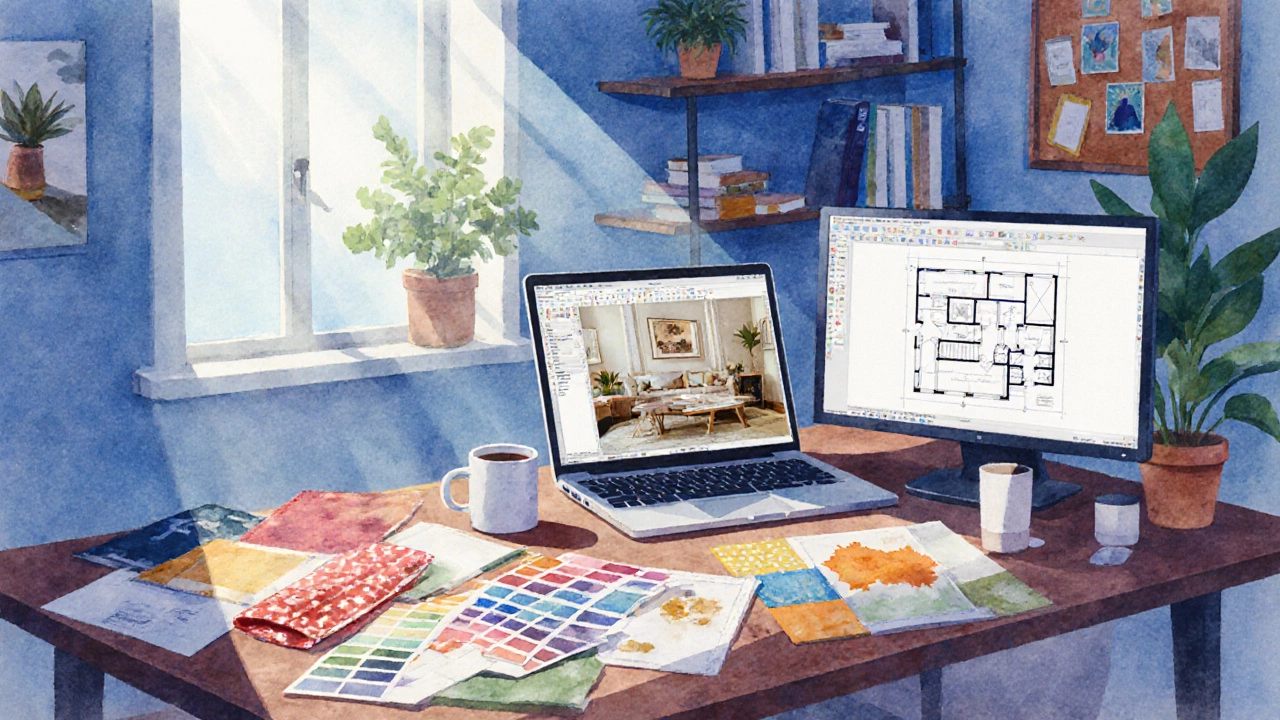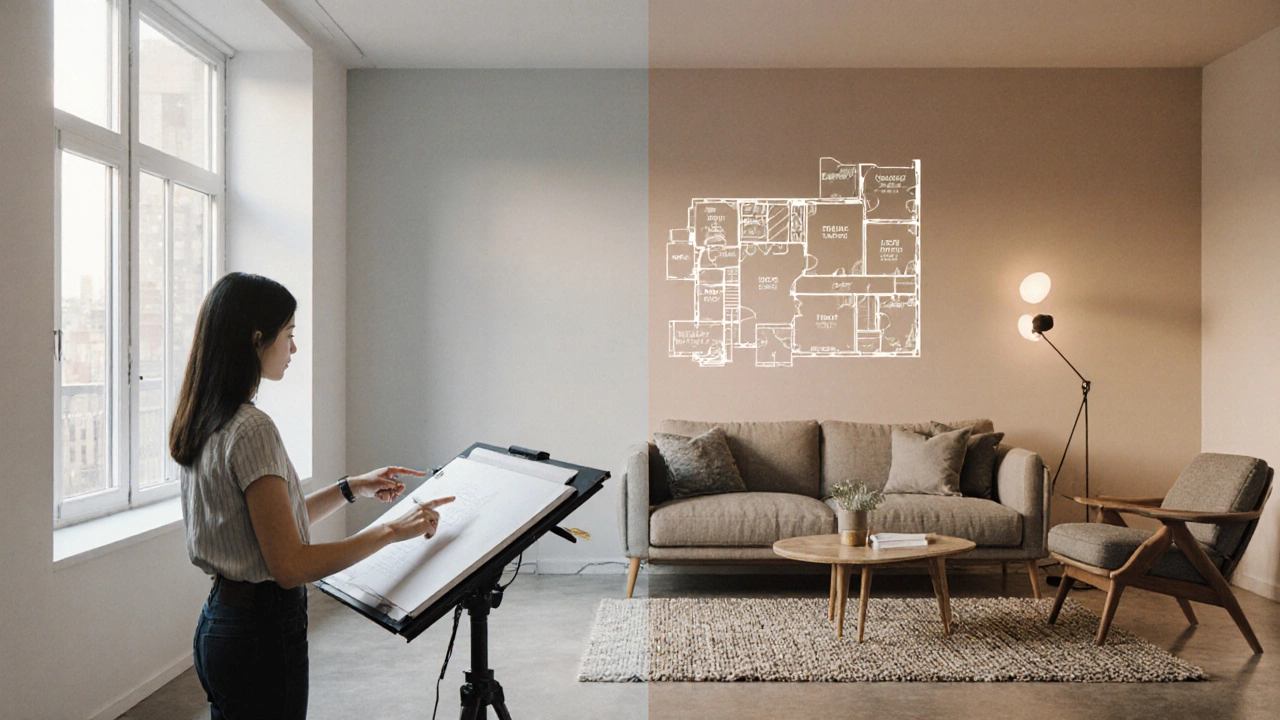When you wonder how to start a career in interior design, the first thing to know is what the field actually covers. Interior Design is a creative discipline that blends art, architecture, and psychology to shape the look and feel of indoor spaces. It involves space planning, material selection, colour theory, and client communication. If you love turning empty rooms into livable art, you’re already on the right track.
Quick Summary
- Identify core skills: visualisation, communication, project management.
- Choose an education path - certificate, associate, or bachelor’s degree.
- Build a strong portfolio with real‑world projects.
- Gain experience through internships, freelance jobs, or volunteering.
- Consider the NCIDQ exam to boost credibility.
- Leverage networking and online platforms for the job hunt.
What Does an Interior Designer Actually Do?
An Interior Designer helps clients create functional, safe, and aesthetically pleasing interiors. Daily tasks include measuring spaces, drafting floor plans, selecting finishes, sourcing furniture, and presenting mood boards. Designers also coordinate with contractors, electricians, and suppliers to keep projects on schedule and within budget.
Key Skills and Traits You’ll Need
Even before you enroll in a program, start sharpening these abilities:
- Visualisation - imagine spaces before they’re built.
- Communication - translate ideas to clients and tradespeople.
- Project Management - juggle timelines, budgets, and vendors.
- Attention to Detail - a tiny mis‑measurement can derail a whole room.
- Trend Awareness - stay current with colour palettes, materials, and technology.
Education Paths: Which One Fits You?
There isn’t a one‑size‑fits‑all route. Below is a quick look at the most common options.
| Path | Typical Length | Key Coursework | Cost (CAD) | Best For |
|---|---|---|---|---|
| Certificate | 6‑12 months | Design fundamentals, drafting, software basics | 5,000‑10,000 | Career switchers, budget‑conscious learners |
| Associate Degree | 2 years | Space planning, material studies, interior construction | 12,000‑20,000 | Those who want a solid base before a bachelor’s |
| Bachelor’s Degree (BFA or BDes) | 4 years | Advanced design theory, sustainability, professional practice | 25,000‑45,000 | Students aiming for senior roles or teaching positions |
| Self‑Study + Workshops | Variable | Software tools, trend seminars, portfolio building | 1,000‑5,000 | Highly motivated autodidacts |
In Canada, schools like Vancouver Design Institute and the British Columbia Institute of Technology offer accredited programs that fulfill the NCIDQ eligibility requirements.

Building a Portfolio That Gets Noticed
Your portfolio is the single most important marketing tool you’ll have. Treat it like a visual résumé.
Start with class projects, redesign a room in your own house, or volunteer for a local community centre. Document each project with before‑and‑after photos, mood boards, material palettes, and a short narrative explaining the design challenge and solution.
When you’re ready, create a digital version using SketchUp 3‑D modelling software popular among interior designers or AutoCAD industry‑standard drafting tool. Host it on a personal website, Behance, or a dedicated portfolio platform.
Getting Real‑World Experience
Experience is the bridge between theory and practice.
- Internships: Look for paid or unpaid positions with local design firms. Even a 3‑month stint can give you exposure to client meetings, budgeting, and site visits. In Vancouver, firms like Studio K often take interns during the summer.
- Freelance Projects: Offer to redesign a friend’s office or a small Airbnb. Real clients will test your communication and time‑management skills.
- Volunteer Work: Non‑profits frequently need help with event spaces or community centres. It’s a win‑win-good deeds and portfolio material.
Certification: The NCIDQ Exam
If you want to stand out, consider the NCIDQ Exam the nationally recognized credential for interior designers in North America. It covers three sections: ID Fundamentals, ID Project Management, and ID Programming & Construction. Passing it signals to employers that you meet industry standards.
Preparation resources include the NCIDQ Study Guide, online practice exams, and local study groups. Many schools embed NCIDQ‑ready coursework into their bachelor programs, so you may already be on the path as you study.

Job‑Search Strategies That Actually Work
Once your portfolio is polished and you have a few hours of experience, it’s time to look for a full‑time role.
- Network Locally: Attend design expos, meet‑ups, and city planning workshops. Vancouver’s Design Week is a hotspot for recruiters.
- Online Platforms: Set up a profile on LinkedIn, Indeed, and industry sites like Houzz. Regularly share project snippets to stay visible.
- Direct Applications: Identify firms whose style matches yours and send a tailored cover letter that references a specific project of theirs you admire.
- Freelance Marketplaces: Upwork and Fiverr can provide short‑term gigs that lead to longer contracts.
Remember, the goal isn’t just to get any job-it’s to land a position that helps you grow toward the interior design career you envision.
Common Pitfalls and Pro Tips
Even seasoned designers stumble. Here’s what to watch out for:
- Ignoring the Budget: Clients care about cost as much as aesthetics. Include realistic price ranges in every proposal.
- Over‑Designing: Simpler often wins. Focus on functionality first, style second.
- Skipping Contracts: A basic agreement protects both you and the client. Use templates from design associations.
- Neglecting Continuing Education: Trends shift fast. Subscribe to design magazines, attend webinars, and refresh software skills yearly.
Mini FAQ
Do I need a college degree to become an interior designer?
A degree isn’t mandatory everywhere, but most employers prefer a formal education-especially if you plan to sit for the NCIDQ exam. Certificates and associate programs can also launch your career if you pair them with strong portfolios and experience.
How long does it take to build a competitive portfolio?
You can start showcasing work after a few class projects, but a truly competitive portfolio usually contains 8‑12 varied projects and takes 1‑2 years of focused effort to refine.
What software should I learn first?
Begin with SketchUp for quick 3‑D visualisation, then add AutoCAD for precise drafting. Many firms also use Revit for BIM, but mastering SketchUp and AutoCAD gives you a solid foundation.
Is the NCIDQ exam required in Canada?
Canada doesn’t enforce NCIDQ licensing nationwide, but many provinces and employers recognize it as a mark of professionalism. It can set you apart in competitive job markets like Vancouver.
How can I find internships without prior experience?
Leverage school career services, attend local design networking events, and reach out directly to firms with a brief intro and a link to your portfolio. Even asking for a short shadowing day can turn into a longer internship.
Starting a career in interior design is a mix of learning, creating, and connecting. Follow the steps above, stay curious, and you’ll be on your way to designing spaces that people love.








